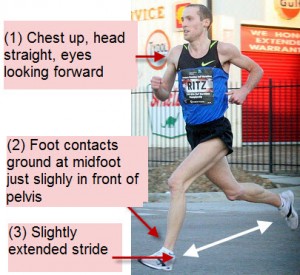Ask a group of runners from anywhere in the world what races are on their running bucket list, chances are you will hear the same marathons over and over: London, New York, Paris, Frankfurt, Vancouver, Athens, Great Wall of China.
Ask any American, and you are almost guaranteed to hear one marathon: Boston.
As the oldest and most prestigious marathon in the States, the Boston Marathon has become its own phenomenon. As a Brit living in America, at first I did not understand the hype, SURELY a New York or a California marathon would be a better choice?
It was not until the Boston Marathon bombings that I saw that it was not just Boston, this was the entire running community, if not the country, who gets excited for this race.
And that’s when I set out to research exactly how to tackle the infamous course. Drawing upon scientific papers and conversations with experience Boston racers, I’ve put together this guide that will not only help you conquer Boston, but challenge any hilly marathon course.
[ls_content_block id=”34485″]

Training for the hills of Boston
When you think of Boston marathon, what comes to mind?
Other than a Boston Qualifier; possibly the most sought after running goal by Americans, hills are not far behind.
Boston is known for its hills, not just heartbreak, but also the downhill’s that make those last few miles of a marathon even more painful.
Everyone thinks that the uphills affect your race, and they do, but what goes up must come down, and by far the most difficult part of the Boston course are those darn hills. With that in mind, here are our best tactics to make sure you can be as prepared as possible for your next hilly race.
Proper form when running downhill
In 2012, we gave you technical advice on how to run downhills with good running form, and earlier this week Matt Fitzgerald gave you his 10 Best Tips to Tame the Hills of Boston.
Running downhills with good form is extremely important, as it involves eccentric loading- the hill causes your quads to contract to stabilize the knee (and keep you upright), while your knee is simultaneously flexing and your quad is stretching.
This means that your quads are being pulled in two different directions, which can put significant stress on them.
That can be difficult to get your head around, but like they say, a picture says a thousand words. Rather than (attempting to) describe correct form to you, here is a clear image of that correct form in action.
How to practice downhill running (even if you don’t have hills nearby)
Thankfully, as with most running related topics, practicing running downhill running increases your muscles fatigue resistance, and as long as you increase your downhill running slowly, your body will adjust to the downhills, with less resulting soreness.
If you are fortunate enough to live in an area that has downhills readily available, you may be able to build your fatigue resistance without any additional planning.
Many elite athletes use the following techniques to practice downhill running
- Point to point steady state runs
- Getting a friend to drop you off at a highest point, and pick you up at a low point, this allows you to practice running downhill without the added strain of the uphills.
- Mile repeats over a gradual downhill
- Again, a friend would need to drive you back up to the top during your recovery. This would allow you to practice running race pace while running downhill.
However, if hills are not easy to find, or during the winter months, there are a few ways to be creative with downhill running practice.
Tilting/decline setting treadmills
Treadmills that can decline have become popular in recent years, as a way to prepare for hilly marathons.
A lot of treadmills now come with 3% decline settings, and this can be used for workouts or bouts within your regular runs. Proform, one of the Boston Marathon sponsors this year, make many varieties of treadmills with decline settings. Proform even has two special edition Boston Marathon 3.0 and 4.0 treadmills with up to a 6% decline!
If you do not have a few thousand dollars to spend on a new treadmill, placing wooden/cement blocks under the back legs of a treadmill to create a decline for training runs is one alternative. We showed you how to do this on our post comparing Outdoor and Treadmill Running. This is considered effective, although there are yet to be any studies completed on this.

Additional downhill running tips
- Wearing a weight jacket can help prepare your quads for additional pounding that will occur with the eccentric loading. However, this can put additional strain on all muscles, which is not recommended for long periods, and can increase injury risk.
- Exercises such as wall sit and one-legged squats can be another way to practice eccentric loading on your quads, without affecting your workouts.
- Running a few downhill step workouts throughout your marathon segment is another way to induce the same eccentric loading. This may be a workout you want to use in the earlier stages of build up, and will need to be extremely careful as you become fatigued…no-one wants a broken nose!
- Finally, one additional running related method commonly used in flat areas is to find an overpass in your town. Although it can be repetitive and boring, this can be one way of practicing downhill’s in an area where there are none.
The most important advice for practicing downhills is to make sure that you gradually add them to your training, and you should gradually increase the grade as you get used to running them. The more you are able to practice (over time) the better adapted your body will be.
Padulo et al. found that elite runners can run downhills more efficiently than amateur runners with less experience. This is not another of those instances where life is just easier for elite runners, but instead they found that it is all about practicing downhills as much as possible. Padulo et al. concluded that more practice leads to better efficiency, which means that no matter what hills you can find, or how you simulate downhill running, it is important to do so.
As we have mentioned, downhill running puts a great deal of extra strain on your muscles, and injury risk increases with any form of additional strain.
RunnersConnect Bonus
Racing Boston marathon this year? Download your FREE Boston Marathon Pace Calculator now.
The Boston Marathon pace calculator uses the steepness of the hill, along with its length, to assign a difficulty score for each mile. Each mile is then extracted to provide you with the perfect pace per mile to maintain an even effort throughout the entire race.
The calculator will keep you from going out over your head over the first few miles and fading on the Newton Hills.
What creative ways do you use to simulate race conditions? If you have raced Boston before, what advice would you give to those preparing for it?







